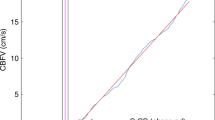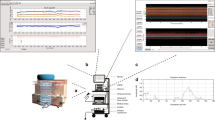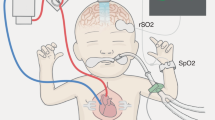Abstract
Objective:
To determine the normal range of resistive index (RI) variability in clinically/neurologically unremarkable preterm and term infants and to compare the hemodynamic response to transient elevation of intracranial pressure.
Study Design:
We measured RIs at baseline and following brief fontanel compression, assessing for differences in mean baseline and compression values and percent change.
Result:
One hundred and twenty-nine subjects were included in the study. Mean baseline RI and normal range were 0.7 in preterm (0.54 to 0.86) and 0.66 in term infants (0.52 to 0.8; P=0.001). Mean RI during compression was 0.71 in preterm and 0.68 in term infants (P=0.015). Mean percent change between baseline and compression was 5.86% in preterm and 7.45% in term infants (P=0.092).
Conclusion:
No difference in the hemodynamic response to transient elevation of intracranial pressure between different gestational groups, suggesting no significant differences in autoregulatory response.
This is a preview of subscription content, access via your institution
Access options
Subscribe to this journal
Receive 12 print issues and online access
$259.00 per year
only $21.58 per issue
Buy this article
- Purchase on Springer Link
- Instant access to full article PDF
Prices may be subject to local taxes which are calculated during checkout


Similar content being viewed by others
References
Strandgaard S, Paulson OB . Cerebral autoregulation. Stroke 1984; 15: 413–416.
Seibert JJ, McCowan TC, Chadduck WM, Adametz JR, Glasier CM, Williamson SL et al. Duplex pulsed doppler US versus intracranial pressure in the neonate: clinical and experimental studies. Radiology 1989; 171: 155–159.
Bada HS, Hajjar W, Chua C, Sumner DS . Noninvasive diagnosis of neonatal asphyxia and intraventricular hemorrhage by doppler ultrasound. J Pediatr 1979; 95: 775–779.
Hill A, Volpe JJ . Decrease in pulsatile flow in the anterior cerebral arteries in infantile hydrocephalus. Pediatrics 1982; 69: 4–7.
Pinto PS, Tekes A, Singhi S, Northington FJ, Parkinson C, Huisman TA . White-gray matter echogenicity ratio and resistive index: sonographic bedside markers of cerebral hypoxic-ischemic injury/edema? J Perinatol 2012; 32: 448–453.
Lundell BP, Lindstrom DP, Arnold TG . Neonatal cerebral blood flow velocity I. an in vitro validation of the pulsed Doppler technique. Acta Paediatr Scand 1984; 73: 6–810.
Goh D, Minns RA, Hendry GM, Thambyayah M, Steers AJ . Cerebrovascular resistive index assessed by duplex doppler sonography and its relationship to intracranial pressure in infantile hydrocephalus. Pediatr Radiol 1992; 22: 246–250.
Taylor GA . Effect of scanning pressure on intracranial hemodynamics during transfontanellar duplex US. Radiology 1992; 185: 763–766.
Taylor GA, Madsen JR . Neonatal hydrocephalus: hemodynamic response to fontanelle compression— correlation with intracranial pressure and need for shunt placement. Radiology 1996; 201: 685–689.
Taylor GA, Phillips MD, Ichord RN, Carson BS, Gates JA, James CS . Intracranial compliance in infants: evaluation with doppler US. Radiology 1994; 191: 787–791.
Pryds O . Control of cerebral circulation in the high-risk neonate. Ann Neurol 1991; 30: 321–329.
Meek JH, Tyszczuk L, Elwell CE, Wyatt JS . Low cerebral blood flow is a risk factor for severe intraventricular haemorrhage. Arch Dis Child Fetal Neonatal Ed 1999; 81: F15–F18.
Chadduck WM, Seibert JJ, Adametz J, Glasier CM, Crabtree M, Stansell CA . Cranial doppler ultrasonography correlates with criteria for ventriculoperitoneal shunting. Surg Neurol 1989; 31: 122–128.
Riggo JD, Kolarovszki B, Richterova R, Kolarovszka H, Sutovsky J, Durdikc P . Measurement of the blood flow velocity in the pericallosal artery of children with hydrocephalus by transcranial doppler ultrasonography—preliminary results. Biomed Pap Med Fac Univ Palacky Olomouc Czech Repub 2007; 151: 285–289.
de Oliveira RS, Machado HR . Transcranial color-coded doppler ultrasonography for evaluation of children with hydrocephalus. Neurosurg Focus 2003; 15: ECP3.
Couture A, Veyrac C, Baud C, Saguintaah M, Ferran JL . Advanced cranial ultrasound: Transfontanellar doppler imaging in neonates. Eur Radiol 2001; 11: 2399–2410.
Pryds O, Greisen G, Lou H, Friis-Hansen B . Heterogeneity of cerebral vasoreactivity in preterm infants supported by mechanical ventilation. J Pediatr 1989; 115: 638–645.
Tsuji M, Saul JP, du Plessis A, Eichenwald E, Sobh J, Crocker R et al. Cerebral intravascular oxygenation correlates with mean arterial pressure in critically ill premature infants. Pediatrics 2000; 106: 625–632.
Boylan GB, Young K, Panerai RB, Rennie JM, Evans DH . Dynamic cerebral autoregulation in sick newborn infants. Pediatr Res 2000; 48: 12–17.
Tyszczuk L, Meek J, Elwell C, Wyatt JS . Cerebral blood flow is independent of mean arterial blood pressure in preterm infants undergoingintensive care. Pediatrics 1998; 102: 337–341.
Horgan JG, Rumack CM, Hay T, Manco-Johnson ML, Merenstein GB, Esola C . Absolute intracranial blood-flow velocities evaluated by duplex doppler sonography in asymptomatic preterm and term neonates. AJR Am J Roentgenol 1989; 152: 1059–1064.
Perlman JM, Hill A, Volpe JJ . The effect of patent ductus arteriosus on flow velocity in the anterior cerebral arteries: ductal steal in the premature newborn infant. J Pediatr 1981; 99: 767–771.
Lemmers PM, Toet MC, van Bel F . Impact of patent ductus arteriosus and subsequent therapy with indomethacin on cerebral oxygenation inpreterm infants. Pediatrics 2008; 121: 142–147.
Lipman B, Serwer GA, Brazy JE . Abnormal cerebral hemodynamics in preterm infants with patent ductus arteriosus. Pediatrics 1982; 69: 778–781.
Siassi B, Blanco C, Cabal LA, Coran AG . Incidence and clinical features of patent ductus arteriosus in low-birthweight infants: a prospective analysis of 150 consecutively born infants. Pediatrics 1976; 57: 347–351.
Author information
Authors and Affiliations
Corresponding author
Ethics declarations
Competing interests
The authors declare no conflict of interest.
Rights and permissions
About this article
Cite this article
Zamora, C., Tekes, A., Alqahtani, E. et al. Variability of resistive indices in the anterior cerebral artery during fontanel compression in preterm and term neonates measured by transcranial duplex sonography. J Perinatol 34, 306–310 (2014). https://doi.org/10.1038/jp.2014.11
Received:
Accepted:
Published:
Issue Date:
DOI: https://doi.org/10.1038/jp.2014.11
Keywords
This article is cited by
-
Cerebral saturation reflects anterior cerebral artery flow parameters by Doppler ultrasound in the extremely premature newborn
Journal of Perinatology (2022)
-
Ultrasound imaging of preterm brain injury: fundamentals and updates
Pediatric Radiology (2022)
-
Evaluating corrected carotid flow time as a non-invasive parameter for trending cardiac output and stroke volume in cardiac surgery patients
Journal of Ultrasound (2022)
-
Normal values of the resistivity index of the pericallosal artery with and without compression of the anterior fontanelle
Pediatric Radiology (2019)
-
Preterm neuroimaging and neurodevelopmental outcome: a focus on intraventricular hemorrhage, post-hemorrhagic hydrocephalus, and associated brain injury
Journal of Perinatology (2018)



